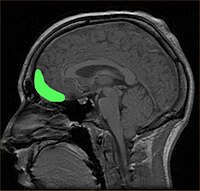
Photo from wikipedia
Sleep is punctuated by transient elevations of vigilance level called arousals or awakenings depending on their durations. Understanding the dynamics of brain activity modifications during these transitional phases could help… Click to show full abstract
Sleep is punctuated by transient elevations of vigilance level called arousals or awakenings depending on their durations. Understanding the dynamics of brain activity modifications during these transitional phases could help to better understand the changes in cognitive functions according to vigilance states. In this study, we investigated the activity of memory‐related areas (hippocampus and orbitofrontal cortex) during short (3 s to 2 min) arousing reactions detected from thalamic activity, using intracranial recordings in four drug‐resistant epilepsy patients. The average power of the signal between 0.5 and 128 Hz was compared across four time windows: 10 s of preceding sleep, the first part and the end of the arousal/awakening, and 10 s of wakefulness. We observed that (a) in most frequency bands, the spectral power during hippocampal arousal/awakenings is intermediate between wakefulness and sleep whereas frontal cortex shows an early increase in low and fast activities during non‐rapid‐eye‐movement (NREM) sleep arousals/awakenings; (b) this pattern depends on the preceding sleep stage with fewer modifications for REM than for non‐REM sleep arousal/awakenings, potentially reflecting the EEG similarities between REM sleep and wakefulness; (c) a greater activation at the arousing reaction onset in the prefrontal cortex predicts longer arousals/awakenings. Our findings suggest that hippocampus and prefrontal arousals/awakenings are progressive phenomena modulated by sleep stage, and, in the neocortex, by the intensity of the early activation. This pattern of activity could underlie the link between sleep stage, arousal/awakening duration and restoration of memory abilities including dream recall.
Journal Title: Human Brain Mapping
Year Published: 2021
Link to full text (if available)
Share on Social Media: Sign Up to like & get
recommendations!